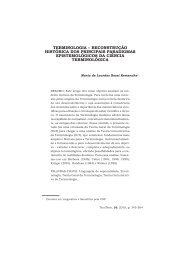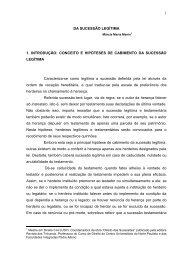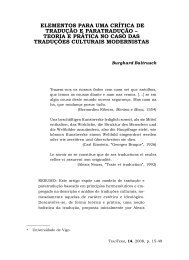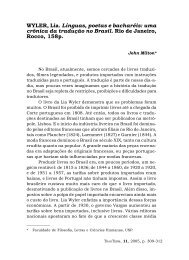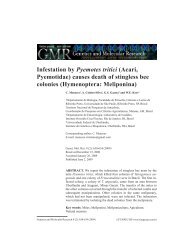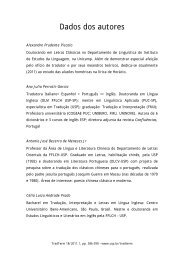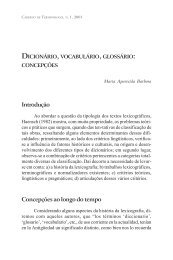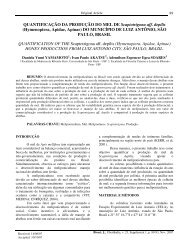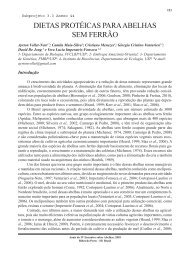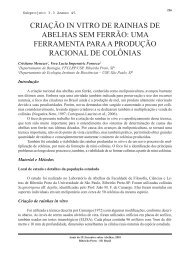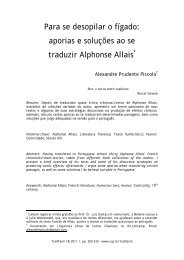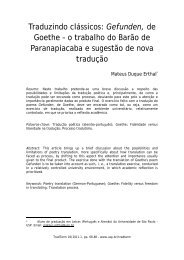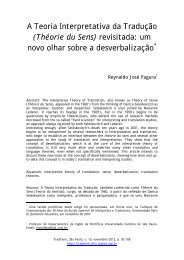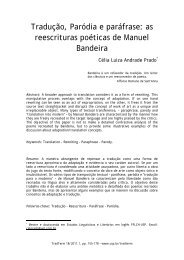Bees as pollinators in Brazil - USP
Bees as pollinators in Brazil - USP
Bees as pollinators in Brazil - USP
Create successful ePaper yourself
Turn your PDF publications into a flip-book with our unique Google optimized e-Paper software.
honey bees were <strong>in</strong>troduced <strong>in</strong> the New World<br />
<strong>in</strong> the middle 1960´s, and they reached Central<br />
America <strong>in</strong> 1985, he compared the coffee<br />
yields of the period before and after its <strong>in</strong>troduction.<br />
After the arrival of Africanized bee <strong>in</strong><br />
Central America, coffee yields <strong>in</strong> most countries<br />
of this region <strong>in</strong>cre<strong>as</strong>ed substantially,<br />
except for the Caribbean countries (e.g. Haiti),<br />
where native and <strong>in</strong>troduced <strong>poll<strong>in</strong>ators</strong> were<br />
absent. In the Old World, where honey bees<br />
were always present, coffee production did<br />
not varied <strong>in</strong> the same rate than the New<br />
World. Countries that experienced an <strong>in</strong>tensive<br />
land usage and loss of habitats for <strong>poll<strong>in</strong>ators</strong><br />
had reduced yields (loss of 20-50%),<br />
although they had <strong>in</strong>cre<strong>as</strong>ed cultivated are<strong>as</strong><br />
(Ivory Co<strong>as</strong>t, Ghana, Kenya, Cameroon,<br />
Indonesia, El Salvador and Haiti) (Roubik,<br />
2002). This work stressed the importance of<br />
native and <strong>in</strong>troduced <strong>poll<strong>in</strong>ators</strong> for coffee<br />
yields, although he did not analyze the poll<strong>in</strong>ation<br />
behaviour itself.<br />
Ricketts (2004), <strong>in</strong> experiments performed<br />
at Costa Rica dur<strong>in</strong>g 2001-2002,<br />
showed that eleven eusocial bees (10 native<br />
plus A. mellifera) were the most common visitors<br />
of coffee (C. arabica) shrubs, and that<br />
the distance of the forest fragments to the<br />
cultivated are<strong>as</strong> significantly <strong>in</strong>fluenced coffee<br />
visit<strong>in</strong>g by these bees. Bee richness, overall<br />
visitation rate, and pollen deposition rate<br />
were all significantly higher <strong>in</strong> sites with<strong>in</strong><br />
approximately 100m of forest fragments than<br />
<strong>in</strong> sites far away (up to 1.6km). Apis mellifera<br />
foragers accounted for more than 90% of all<br />
visits <strong>in</strong> distant sites, and where Apis were not<br />
present, native species <strong>as</strong> melipon<strong>in</strong>e bees<br />
accounted for most of the visits at near sites.<br />
This is due to the smaller flight range of<br />
melipon<strong>in</strong>e bees which have a typical flight<br />
range of 100-400m (van Niewestadt &<br />
Iraheta, 1996, Heard, 1999), although maximum<br />
observed flights ranged from 1 to 2 km<br />
Workshop I 79<br />
(Roubik & Aluja, 1983). When Apis abundance<br />
decl<strong>in</strong>ed substantially, from 2001 to<br />
2002, visitation rates dropped about 50% <strong>in</strong><br />
distant sites, but only 9% <strong>in</strong> near sites. This<br />
can be expla<strong>in</strong>ed by the compensat<strong>in</strong>g effect<br />
of native bees, which replaced Apis <strong>as</strong> the<br />
most important visitor <strong>in</strong> nearby sites. So,<br />
accord<strong>in</strong>g to the author, forest fragments<br />
provided nearby coffee with a diversity of<br />
bees that <strong>in</strong>cre<strong>as</strong>ed both the amount and stability<br />
of poll<strong>in</strong>ation services by reduc<strong>in</strong>g<br />
dependence on a s<strong>in</strong>gle <strong>in</strong>troduced poll<strong>in</strong>ator<br />
(Ricketts, 2004).<br />
Similar results were found <strong>in</strong> <strong>Brazil</strong> (De<br />
Marco & Coelho, 2004) and Indonesia (Kle<strong>in</strong>,<br />
et al., 2003b,c). Coffee (C. arabica) branches<br />
with free access to <strong>poll<strong>in</strong>ators</strong> produced more<br />
fruits <strong>in</strong> farms where there were forest fragments<br />
nearby. Coffee production <strong>in</strong>cre<strong>as</strong>ed<br />
14.6% when the services of <strong>poll<strong>in</strong>ators</strong> were<br />
available (De Marco & Coelho, 2004). Similarly,<br />
C. canephora and C.arabica fruit set <strong>in</strong>cre<strong>as</strong>ed<br />
with the <strong>in</strong>cre<strong>as</strong>e of diversity and abundance<br />
of flower-visit<strong>in</strong>g bees (C. arabica: 90% when<br />
20 bee species were present and 60% when<br />
only three species were present, Kle<strong>in</strong>, et al.,<br />
2003b; C. canephora: 95% when 20 or more<br />
bee species were present and 70% when only<br />
six species were present, Kle<strong>in</strong>, et al., 2003c),<br />
and the number of social bees species<br />
decre<strong>as</strong>ed with distance to forest fragments<br />
and the number of solitary bees <strong>in</strong>cre<strong>as</strong>ed with<br />
light <strong>in</strong>tensity (less shade) and greater quantities<br />
of blossoms. Additionally, Kle<strong>in</strong>, et al.,<br />
(2003b,c) found that solitary bees had an<br />
important participation <strong>in</strong> the poll<strong>in</strong>ation of C.<br />
canephora shrubs, lead<strong>in</strong>g to higher levels of<br />
fruit set that orig<strong>in</strong>ated by members of social<br />
bee <strong>as</strong>semblages.<br />
These services can be translated <strong>in</strong>to economic<br />
advantages. For example, De Marco &<br />
Coelho (op.cit.) found, <strong>as</strong> previously stated,<br />
that coffee production <strong>in</strong>cre<strong>as</strong>ed 14.6% when



